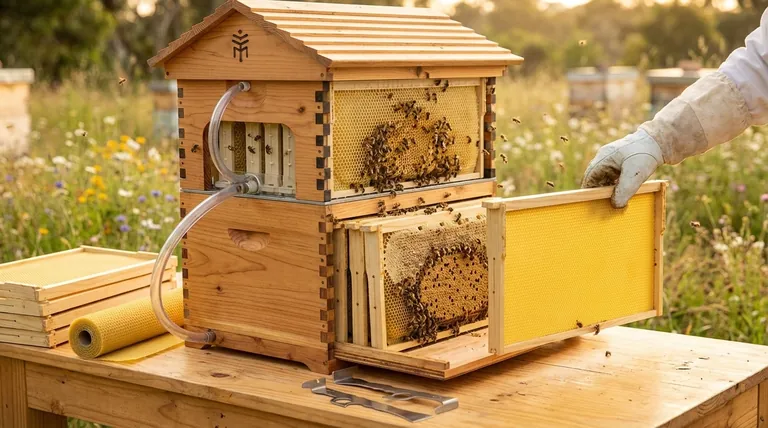In a Flow Hive, foundation is not used in the honey collection frames at all. The patented "Flow Frames" in the honey super arrive with a pre-formed, food-grade plastic honeycomb matrix already built. The only part of the hive where you must decide about using foundation is in the separate brood box, where the queen lays her eggs.
The core concept of the Flow Hive is a separation of functions. The honey super uses pre-built plastic comb technology that bypasses the need for foundation, while the brood box operates like a traditional hive, leaving the choice of foundation up to the beekeeper.

The Two Distinct Zones of a Flow Hive
To understand how foundation works—or doesn't work—in a Flow Hive, you must see it as two separate environments for the bees, each with a different purpose.
The Flow Super: No Foundation Needed
The top box, or "super," is where the honey for harvesting is stored. This is where the Flow Hive's unique technology resides.
The Flow Frames within this super are not empty. They contain a complete, food-grade plastic honeycomb matrix of partially formed cells. The bees' only jobs here are to complete the cells with their own wax, fill them with honey, and cap them.
The Brood Box: Your Choice to Make
The bottom box is the brood chamber. This is the heart of the colony, where the queen lays eggs and the bees raise their young.
This part of the hive functions identically to a standard Langstroth hive. The frames that come with the brood box are typically empty, meaning you must decide whether to add foundation (wax or plastic) or to let the bees build their own comb naturally (foundationless).
How the Flow Frame Replaces Traditional Foundation
The innovation of the Flow Frame is that it entirely removes the bees' need to build the core honeycomb structure for honey storage, saving them a tremendous amount of time and energy.
A Pre-Built Plastic Matrix
Think of the Flow Frames as providing a perfect, man-made scaffold. The bees recognize the cell shapes and immediately begin to work on them.
The Bees' Role: Finishing and Filling
While the bees don't build the structure, they still interact with it naturally. They coat the plastic cells with a thin layer of beeswax, draw out the edges, and prepare them for honey storage, just as they would with natural comb.
The "Splitting Cell" Harvesting Mechanism
This is the key reason traditional foundation is incompatible with the system. When you turn the Flow Key, the pre-formed plastic cells inside the frame shift and split vertically.
This split creates channels that allow the honey to flow down and out of the hive through tubes, all without uncapping, extracting, or disturbing the bees. Once harvested, the cells are reset, and the bees can begin refilling them.
Understanding the Trade-offs
This innovative system presents a clear set of advantages and limitations compared to traditional beekeeping methods.
Pro: Unmatched Speed and Efficiency
By providing the comb structure, the Flow Hive allows the bee colony to focus its energy directly on foraging and honey production. This can lead to faster honey storage during a nectar flow.
Con: The Brood Box Decision Remains
The Flow Hive simplifies honey harvesting, but it does not remove the core responsibilities of beekeeping. You still must manage the health of the brood box, which involves the traditional choice of using foundation or going foundationless.
Con: Plastic in the Hive
The Flow Frames are made from high-quality, BPA-free plastic. However, for beekeepers aiming for a completely natural, wax-only hive environment, this reliance on a plastic component for honey storage is a significant drawback.
Making the Right Choice for Your Brood Box
Since the honey super is a fixed system, your only decision regarding foundation is for the brood box.
- If your primary focus is rapid colony growth and straight combs: Use wax or plastic foundation in your brood frames to guide the bees and ensure easily manageable frames.
- If your primary focus is a more "natural" beekeeping approach: Use foundationless frames in the brood box, allowing the bees to build their own comb with cell sizes of their choosing.
Understanding this division between the automated honey super and the traditional brood box is the key to managing your Flow Hive effectively.
Summary Table:
| Hive Section | Foundation Required? | Purpose | Key Feature |
|---|---|---|---|
| Flow Super | No | Honey Storage | Pre-built plastic honeycomb matrix for easy harvesting |
| Brood Box | Yes (Your Choice) | Brood Rearing | Functions like a standard Langstroth hive |
Ready to optimize your beekeeping operation? Whether you manage a commercial apiary or distribute beekeeping equipment, HONESTBEE supplies the high-quality foundation, frames, and other essential supplies you need for traditional brood box management. Our wholesale-focused operations ensure you get reliable, durable equipment at competitive prices.
Contact HONESTBEE today to discuss your supply needs and elevate your beekeeping efficiency!
Visual Guide

Related Products
- HONESTBEE Advanced Ergonomic Stainless Steel Hive Tool for Beekeeping
- Long Langstroth Style Horizontal Top Bar Hive for Wholesale
- Professional Dual-End Stainless Steel Hive Tool for Beekeeping
- Professional 3-Bar Frame Grip with Integrated Hive Tool
- Beehive Handle and Frame Rest Cutting Machine: Your Specialized Hive Machine
People Also Ask
- How should beekeepers handle bees when using a hive tool? Master Calm, Deliberate Techniques
- What is a hive tool and what are its uses? Master Your Hive Inspections with the Essential Beekeeper's Tool
- What tools are used for cleaning frames? A Beekeeper's Simple 4-Tool Guide
- Why is it important to compare the progress of different hives? A Beekeeper's Key Diagnostic Tool
- Why do hive tools have a hole? Unlock the Secret to Efficient Beekeeping



















